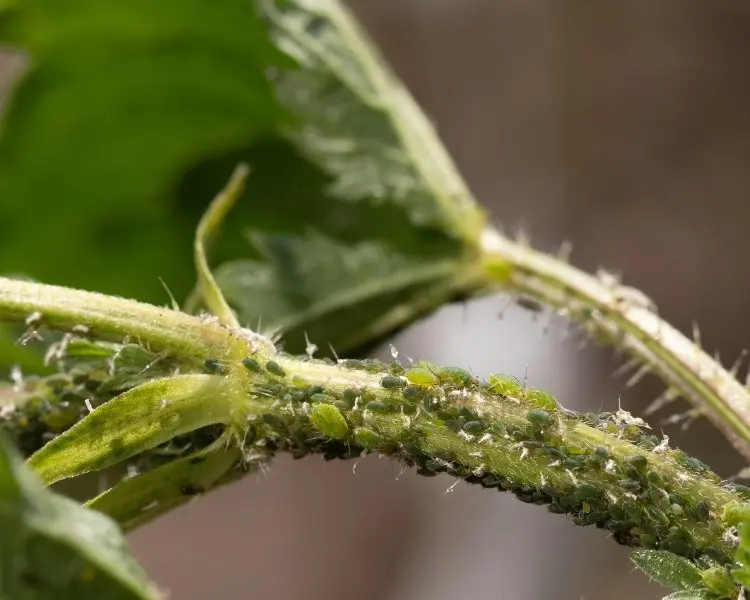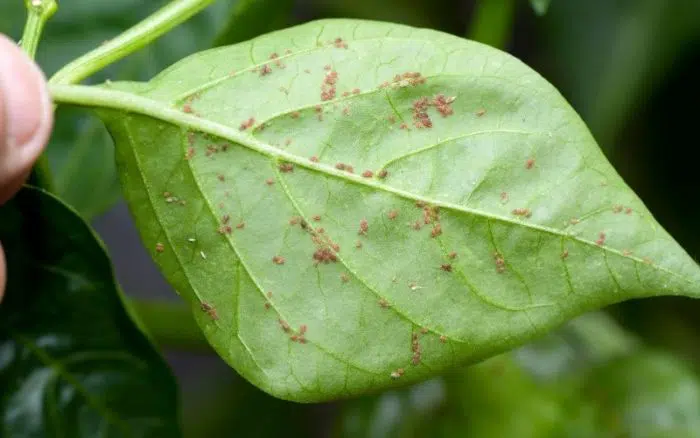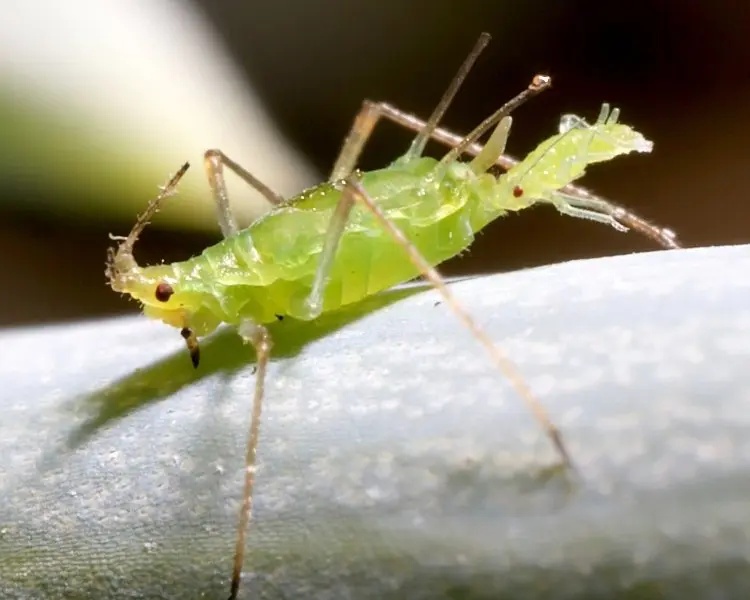Ugh aphids – the glitter of the garden!
It seems like they are always lurking around, but you rarely notice them. Once you see one, you see tons of them multiply seemingly out of nowhere!
Unfortunately, tomato plants are a common target for aphids. These insects feed on the sap of the leaves and can cause serious damage to the plant, often leading to reduced yields or even loss of the crop.
Let’s catch aphids before they cause tons of damage so we have healthy tomato plants this season.
What are Aphids?
Aphids are small insects that feed on the sap of plants. They can be found on a wide variety of different plants, including peppers, tomatoes, and other vegetables.
If you find them in your garden, it’s best to get rid of them as quickly as you can because they multiply like crazy.
There are thousands of species of aphids, with over 200 of those that feed on garden plants. The types of aphids found on tomato plants are typical the green peach aphids and potato aphids.
| Potato Aphid | Green Peach Aphid | |
|  | |
| Coloring | Pink, green pink & green, or light green with dark stripe | Pale yellow or green |
| Shape | Pear-shaped | Pear-shaped |
Aphid Infestation & Damage
Aphids are not something you want to find on your plants because of two reasons:
- They can transmit different plant diseases, carrying it from one plant to another.
- They feed on the sap in leaves, which can stress out the plants enough to stunt growth.
Aphids feed on plant sap so causing stunted growth, wilting foliage, leaf curling and yellowing of the leaves.
They can also transmit plant viruses like tomato mosaic and potato leaf roll viruses.

How to Get Rid of Aphids on Tomato Plants
Alright, let’s talk about how we can get rid of and start controlling aphids in the garden.
1. Hand Removal
This is the most straightforward method if you catch an aphid infestation early.
If you only see a few aphids here and there, it’s best to just squash or remove them yourself. Since aphids reproduce really fast, if you take the time to go to the store, get some remedies and come back the next day, the colony might have doubled.
Aphids won’t bite you, so you can just squash them between your fingertips right on the leaves.
2. Spraying Aphids Off Your Plants
As the infestation gets to be more severe, you’re going to want to take more extreme measures. Luckily, you can spray them off the plant with a strong stream of water from a hose or watering wand.
If the plant is young and has delicate tomato leaves that won’t be able to handle a strong spray, you can dip the entire leaf into a jar of room temperature water to remove the aphids.
3. Natural Sprays
Natural sprays can help kill aphids and reduce the reoccurrence of aphid infestations for a little while.
Neem oil is one of my favorite “garden tools” because it works quite well on many insects, aphids being one of them. It’s organic and deemed safe for vegetables and other plants you intend to consume.
Neem oil removes the ability for aphid colonies to be able to feed, helping to stop the damage, and kill them off.
100% cold-pressed neem oil that can be used as a foliar spray for healthy garden plants. Free of water and other additives.
4. Insecticidal Soap
You can purchase insecticidal soaps like this one that will help with getting rid of aphid colonies.
You can also make your own DIY soap with a few ingredients:
- Dish soap (natural, free of perfumes)
- Water
- Vegetable oil
- Spray bottle
Make sure you’re using a dish soap that doesn’t contain a lot of additives – we are spraying this on your plants that you’ll eventually eat and those additives can also impact plant growth.
Add 1 teaspoon of soap and 1 teaspoon of oil, to a half gallon of water and spray on the plants. Since aphids are most often found on the bottom side of the tomato plants leaves, start by spraying there.
The soapy water will suffocate the aphids and they will eventually fall off the plant.
5. Introduce Natural Predators & Beneficial Insects
You can also attract the bugs and predators that feed on aphids as well. This is obviously a natural method and can be quite effective.
Natural predators to aphids include:
- Lady bugs/lady beetles
- Damsel bugs
- Small parasitic wasps
- Syrphid fly larva
Ladybugs eat aphids in their natural environment, and you can either buy huge colonies of these insects (yes, you can get them on Amazon!), or plant flowering plants that attract them to the area – see companion planting below.
Prevention of Aphids
There are some ways to prevent aphids from making it to your tomato plants in the first place. Of course, if you’re already dealing with an infestation, you’ll want to go with some of the methods above.
Proper Spacing and Pruning of Your Tomato Plant
Making sure you are spacing your tomatoes properly is super important.
If you plant tomatoes too close together, you are going to reduce the amount of air flow that can pass between plants. You’re also overcrowding the plants enough that aphid populations (and other tomato pests) can move from one to the next very easily.
Proper pruning of the tomato plant is also essential for getting rid of excess branches and leaves that might be wilting or riddled with fungus.
Companion Planting
Companion planting is the practice of growing two or more plants together in order to help one another.
There are many benefits to companion planting, including reduced need for pesticides and increased yields from your garden. Some plants can help protect other crops from fungal diseases or produce chemicals that repel pests or attract beneficial predators and parasites.
Some great tomato companion plants are:
- Basil
- Garlic
- Chives
- Onions
- Sage
- Mint
- Marigolds
These companions can help improve the health and growth of tomato plants, by suppressing pests like aphids, providing nutrients through their root systems, and helping to prevent fungal diseases.
Attract Lady Bugs
Making your garden a nice hope for ladybugs is a great way to prevent large aphid infestations.
Lady bugs are attracted to quite a few plants in the garden, including:
- Dandelion
- Cilantro
- Dill
- Parsley
- Tansy
- Marigolds
- Chives
- Calendula
- Fennel
No wonder seeing ladybugs around is considered so lucky!
Row Covers
Row covers can come in handy when trying to control aphids if you typically get large infestations in the growing season. This isn’t a perfect method but can help repel aphids by making it extremely hard for them to reach your plants.
Row covers can also be used to protect from as shade cloth to protect plants from the heat and cold.
As tomato plants grow, it can be hard to keep these on as they will need to be pollinated to produce tomato fruit, and they can get quite tall so you’d need a lot of them.
But as an early season prevention method, it can work quite well on younger plants.
Inspect Plants Regularly
I like to check my plants every few days for signs of aphids. Sure, this can be something you do every morning when watering, but I always end up growing too many plants, so I just accept the risk I’m taking.
Aphids on Tomato Plants
Aphids are so common in backyard gardens that if you don’t experience them at some point, are you even a gardener?
Aphids leave behind a sticky substance and can cause stress to your tomato plants. Getting rid of aphids organically can be done, and helps keep these garden pests at bay.
Do you have any other methods you’ve used to keep them from taking over your plants? Let me know in the comments!




